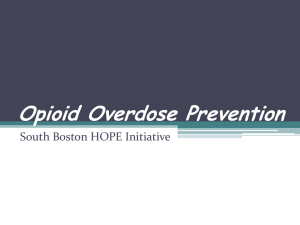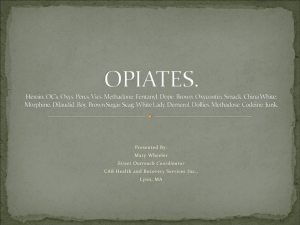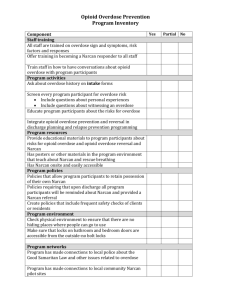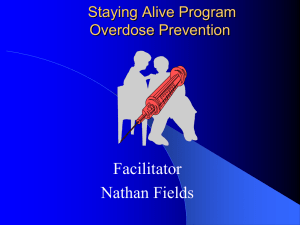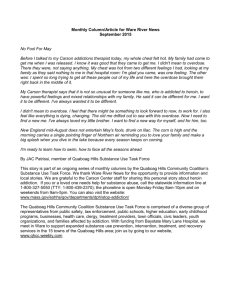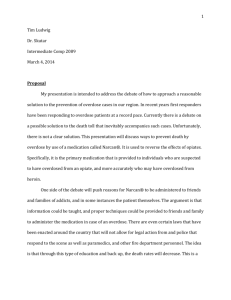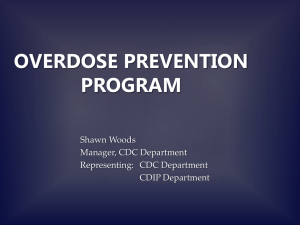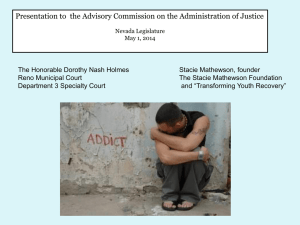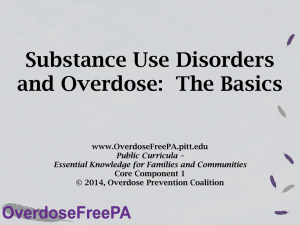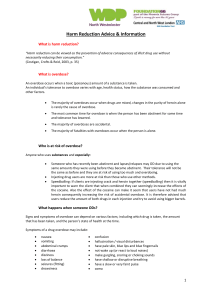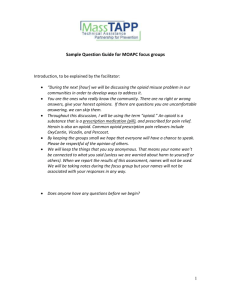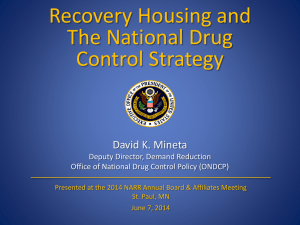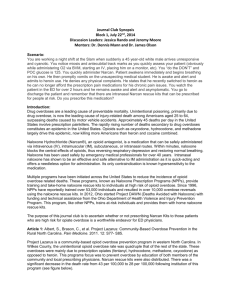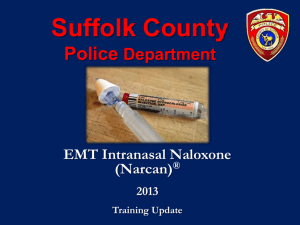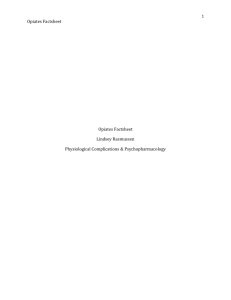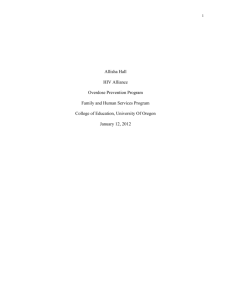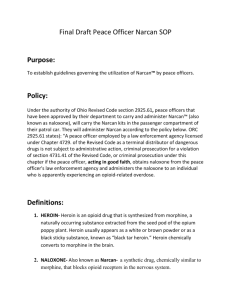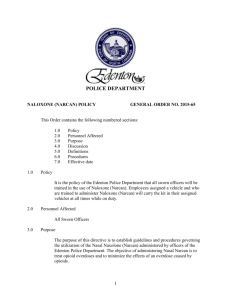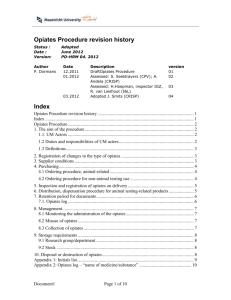File - opioid abuse: AN EPIDEMIC
advertisement
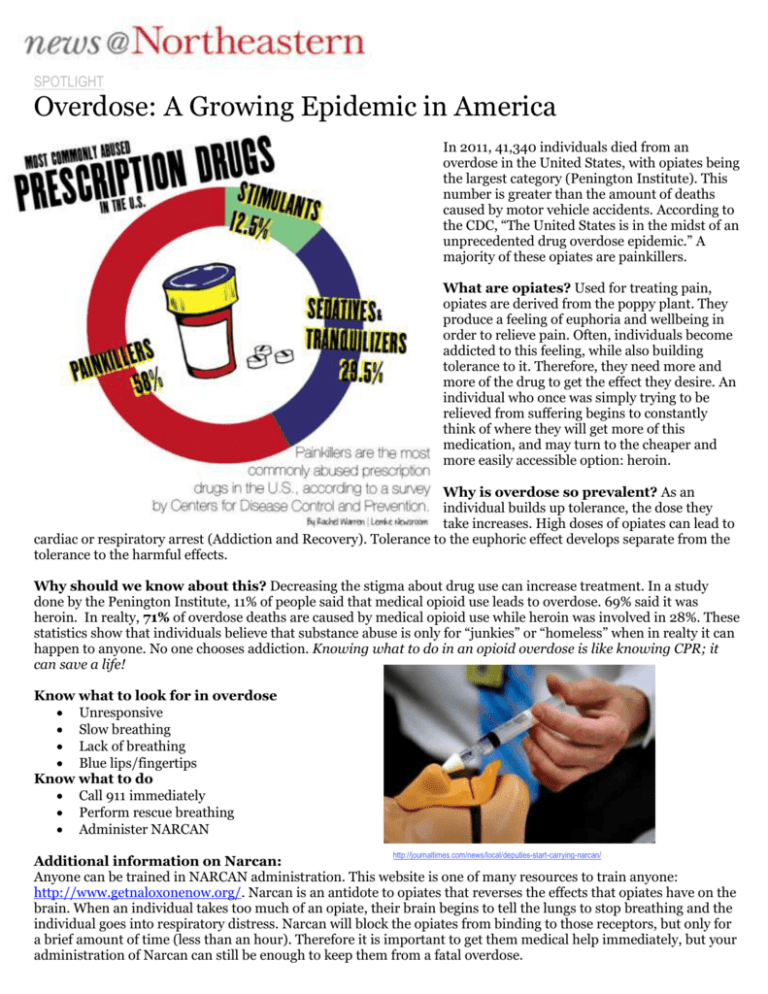
SPOTLIGHT Overdose: A Growing Epidemic in America In 2011, 41,340 individuals died from an overdose in the United States, with opiates being the largest category (Penington Institute). This number is greater than the amount of deaths caused by motor vehicle accidents. According to the CDC, “The United States is in the midst of an unprecedented drug overdose epidemic.” A majority of these opiates are painkillers. What are opiates? Used for treating pain, opiates are derived from the poppy plant. They produce a feeling of euphoria and wellbeing in order to relieve pain. Often, individuals become addicted to this feeling, while also building tolerance to it. Therefore, they need more and more of the drug to get the effect they desire. An individual who once was simply trying to be relieved from suffering begins to constantly think of where they will get more of this medication, and may turn to the cheaper and more easily accessible option: heroin. Why is overdose so prevalent? As an individual builds up tolerance, the dose they take increases. High doses of opiates can lead to cardiac or respiratory arrest (Addiction and Recovery). Tolerance to the euphoric effect develops separate from the tolerance to the harmful effects. Why should we know about this? Decreasing the stigma about drug use can increase treatment. In a study done by the Penington Institute, 11% of people said that medical opioid use leads to overdose. 69% said it was heroin. In realty, 71% of overdose deaths are caused by medical opioid use while heroin was involved in 28%. These statistics show that individuals believe that substance abuse is only for “junkies” or “homeless” when in realty it can happen to anyone. No one chooses addiction. Knowing what to do in an opioid overdose is like knowing CPR; it can save a life! Know what to look for in overdose Unresponsive Slow breathing Lack of breathing Blue lips/fingertips Know what to do Call 911 immediately Perform rescue breathing Administer NARCAN http://journaltimes.com/news/local/deputies-start-carrying-narcan/ Additional information on Narcan: Anyone can be trained in NARCAN administration. This website is one of many resources to train anyone: http://www.getnaloxonenow.org/. Narcan is an antidote to opiates that reverses the effects that opiates have on the brain. When an individual takes too much of an opiate, their brain begins to tell the lungs to stop breathing and the individual goes into respiratory distress. Narcan will block the opiates from binding to those receptors, but only for a brief amount of time (less than an hour). Therefore it is important to get them medical help immediately, but your administration of Narcan can still be enough to keep them from a fatal overdose. Reflective note: The genre that I chose was a web-based project. My goal was to have the project appear as though it is on the Northeastern Website. This means that it is something that students at the University as well as alumni would read. I wanted to do a web-based project because I think that the Internet is a very efficient way to raise awareness and spread news about a very prevalent issue. Many individuals want to know how do we make it stop? I want to let others know that there is still hope. The majority of readers would be in the age range of 18-25, which is very important because according to the New York Times, “more than 20 percent of 18- to 25-year-olds abused prescription pain medication.” Therefore, during our time at school we may be exposed to an individual who has overdosed from opioid medications, whether that is painkillers or heroin. By knowing what to do, we can save a life. I think that this will keep the audience engaged, because there are so many people who know someone who uses or has died from an overdose, and unfortunately the number is growing. In the past month, two people from my hometown have died from overdose. The literacy level for these individuals is very high as Northeastern is an elite university and requires the students to be well educated. The cultural background of students at the university includes 17% international students, 28% from New England, 26% from the Mid-Atlantic, 10% from the west, 10% from the south, 4% from another U.S. territory, and 5% from the Midwest. I think that my layout is simple and my word choices are concise, and I think the use of visuals balances the amount of information. Total word count: 740 *As for placing this piece in my portfolio, I really enjoyed putting this project together. I enjoyed thinking about the audience I was targeting and how this could be used to educate students about opioid use and overdose. I think it would fit well with the other pieces to show how this information is translated to educate different viewers. References Addressing Prescription Drug Abuse in the United States. U.S. Department of Health and Human Services (2013). Retrieved from: http://www.cdc.gov/drugoverdose/pdf/hhs_prescription_drug_abuse_report_09.2013.pdf Opiates (Narcotics): Addiction, Withdrawal and Recovery. Addiction and Recovery (2015). Retrieved from: http://www.addictionsandrecovery.org/ Facts & Stats. International Overdose Awareness Day: Penington Institute (2015). Retrieved from: http://www.overdoseday.com/resources/facts-stats/
